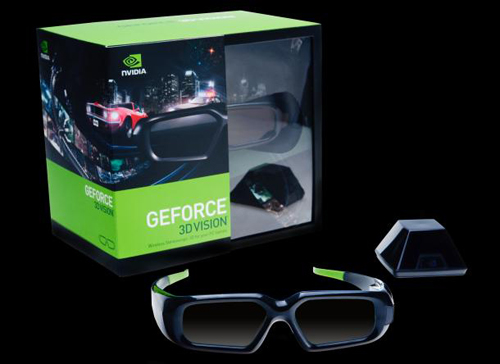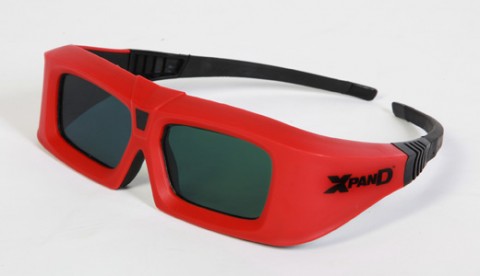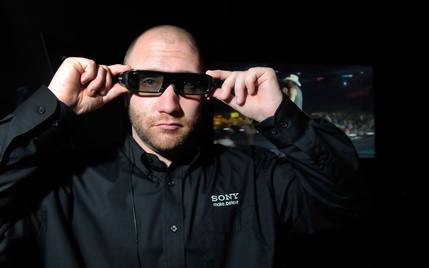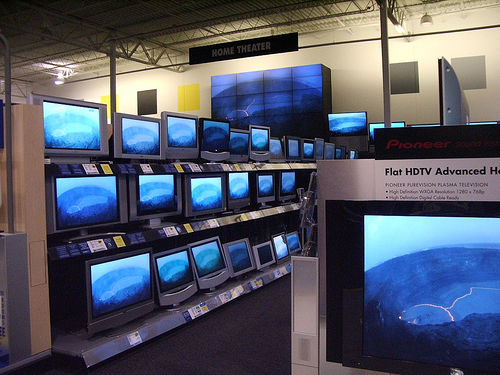
Sky will be starting Europe’s first 3D television channel with coverage of the Barclays Premier League match-up between Manchester United and Chelsea on April 3. They will follow that first match with at least five more Premier League games live in England before the end of the season, as well as the Coca-Cola Football League play-off finals at the end of May.
“It’s fitting that one of the biggest games of the season will be the launch pad for our pioneering Sky 3D service,” said Brian Lenz, Sky’s director of product design and TV product development. “With 3D, seeing really is believing, so it’s great news that over 1,000 pubs across country will be able to show the magic of 3D to their customers.”
Sky 3D plans to add other sports programming as well as movies, tv and film content later in 2010.

NVIDIA just announced their 3DTV Play software technology, which will let you connect your GeForce GPU-powered desktop or notebook computer to new 3D TVs. They are promising the ultimate big screen 3D gaming experience. For the launch of 3DTV Play, NVIDIA is teaming up with Panasonic on its “Touch the Future Tour,” where people can test drive 3DTV Play-based PCs running on the new Panasonic Viera Full HD 3D TVs, that just launched earlier this month.
3DTV Play software lets you connect any compatible NVIDIA GeForce GPU-powered PC or notebook to 3D TVs.
Some Things to know about NVIDIA 3DTV Play:
Can be run on GeForce GPU-based desktop or notebook PCs equipped with an HDMI or DVI connector
Full support for all HDMI 1.4-compatible 3D TVs, including Panasonic VIERA Plasma full HD 3D TVs
Enables 1080p24, 720p60, and 720p50 3D formats
Supports any type of 3D TV including active-shutter TV glasses or passive polarized glasses
Advanced NVIDIA software and graphics drivers automatically convert more than 400 games to stereoscopic 3D in real time, without the need for special patches.
Enjoy full HD Blu-ray 3D playback with real-time GPU accelerated decoding and playback on GeForce GPUs(1)
Watch streaming 3D movies
View 3D photographs directly on the 3D TV
NVIDIA 3DTV Play software will be available later this spring and sold separately with an anticipated U.S. MSRP of $39.99. It will also be available for free for current NVIDIA 3D Visionâ„¢ customers.

The 3DTV market will not be getting the boost it was expecting from Avatar. The highest grossing film of all time, and loser of the Best Picture Oscar, will not be getting a 3D release, due to concerns over market stability.
News Corp. Chief Operating Officer Chase Carey told SmartMoney, that despite the recent hype over at-home 3D TV, the market for 3D products is not stable enough for a release.
“The market is not there in the short-term,” Carey said. He did not turn down the option of releasing a 3D version of Avatar at a later date.

Robert Downey Jr is negotiating a deal to star in Gravity, the 3D space film directed by Alfonso Cuaron. Warner Bros and Legendary Pictures will co-finance the film. Cuaron wrote the script with his son, Jonas. Downey will play the leader of a team posted at a remote space station. While he and a female colleague are traveling outside the space station, the other team members are decimated by debris from an exploded satellite.
Downey was drawn to the chance to work with Cuaron, the director of Children of Men and Y tu mama tambien. Downey will shoot the film in London this summer.
Ami Dror, Chief Strategy Officer for Xpand, says the company’s X101 glasses are used in most 3D theaters outside of America. These active glasses are designed to work with projectors that cycle at 144 frames per second using a “triple flash” technology where it cycles to each eye three times for a movie frame.

Xpand recently announced a deal with Mitsubishi with its X102 glasses, which use a technology called “DLP Link” that puts a tiny flash of white light into a black interstitial frame to control the shutters. This is called active shutter. This will work with 20 projectors using TI’s DLP technology, as well as DLP TVs.
The next set of glasses being released are called the X103 series, and they are designed to be universal active shutter glasses, which will be able to interpret the signals from all the major 3DTV sets – Panasonic, LG, Samsung, Sony, as well as the signals used in Nvidia 3D Vision glasses. The glasses to be in stores by June, and will come in 12 colors. Final pricing wasn’t set yet, but it will probably be in the $125 to $150 range.
CBS Sports is joining up with Cinedigm Digital Cineman Corp. and LG Electronics to televise the Final Four college basketball games on April 3 and the April 5 title game from the 2010 Men’s Division I Basketball Championships in 3D.
Fully produced by CBS Sports, the 3D games will be shown in this enhanced format in 100 movie theaters nationwide, as well as on LG’s LCD HDTVs at locations throughout Lucas Oil Stadium, the 2010 venue for the Final Four.

CBS Sports executive vice president, operations and production Ken Aagaard said that there also have been conversations with cable operators and DirecTV about possibly offering the main games in 3D.
“We’re working with LG. Realistically, there are only a few places because there just aren’t that many homes with boxes to support 3D,” said Aagaard, during an interview after CBS’s annual media day supporting the basketball tournament at the network’s Manhattan headquarters. “This is another platform we can use to leverage the tournament.”
LG is the official 3D sponsor for CBS Sports’ tournament broadcasts and an official Corporate Partner of the NCAA. LG Electronics, which debuted the first 3DTVs in Korea last year, will be introducing this new feature in an extensive line of 3D-enabled LED HDTVs and Blu-ray Disc players in the U.S., starting this May.

Movie site Shadow Locked has prepared a simple guide to avoid getting a headache when you go see a 3D movie.
Most importantly, you should understand why you get the headache in the first place. In traditional 2D movies, the out of focus areas of a scene often have coll little details and info in them that we’ve been conditioned to look at, the action occurring behind the hero, etc. When parts of the picture appear 3D to us, our simple monkey brain gets confused when we try to look at the background details and the background fails to come into focus.
So how do you avoid that 3D headache? Teach your brain to unlearn your experience with 2D movies and stay focused to the in-focus action. When watching a 3D movie, whatever is right in front of you and in-focus is what you want to be paying attention to—focusing on the background details for too long triggers headaches and disorientation.
Thanks Shadowlocked!

So…it must be true!!
Avatar director and King of the World James Cameron has heralded 3D TV as ‘the future’ as he helped launch a range of 3DTV sets at a launch in New York of Samsung 3D sets. He told the crowd: ‘You will all remember that you were here, in Times Square, for the launch of the television of the future.’
Bill Moir, head of marketing at electrical specialist Comet said: ‘Our first 3DTVs will be available to pre-order online from the end of March and available in stores in April. “”We’ve already seen a lot of demand for the new technology. Thousands of customers have already registered their details online with us to receive more information about 3DTV ahead of the UK launch.” Experts predict that within five years every full-size television will have 3D capability.

Sony has released the official pricing on its active shutter 3D glasses as well as emitter, where both of them will go with the 3D-capable 2010 BRAVIA TV. Starting in June, the TDG-BR100 as well as the TDG-BR50 active shutter 3D glasses will retail for around $133 after conversion.
The 3D glasses are adjustable to help out those of us with glasses or huge heads.
As for the 3D infrared emitter, it will sell for $55. Although if you buy the BRAVIA LX900 series you are in luck as the TV already comes with the emitter integrated within.

Best Buy will be joining Panasonic to promote 3D television sets this quarter, as flat panel televisions continue selling at an atypical pace.
Panasonic will discount the prices of the 3D models by 50% as it creates demand for the new category using pricing as its positioning point. Best Buy will release and expand Panasonic’s new category to over 1,000 stores. Pricing for a 3D 50-inch model will start at around $2,500, and that’s after the near-50% discount. A standard 50″ LCD television goes for about half of $2,500 right now from several brands on Best Buy’s website.
Forecasts have 3D television becoming a 15.6 million-unit business in 2013 after a 500,000-unit business last year.









